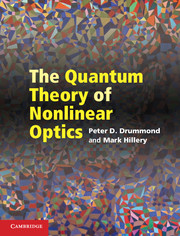Book contents
- Frontmatter
- Contents
- Preface
- Introduction
- 1 Classical nonlinear optics
- 2 Field quantization
- 3 Quantized fields in dielectric media
- 4 Microscopic description of media
- 5 Coherence and quantum dynamics in simple systems
- 6 Decoherence and reservoirs
- 7 Phase-space distributions
- 8 Single-mode devices
- 9 Degenerate parametric oscillator
- 10 Quantum field dynamics
- 11 Quantum propagation in fibers and waveguides
- 12 Quantum information
- List of symbols
- Index
Introduction
Published online by Cambridge University Press: 05 May 2014
- Frontmatter
- Contents
- Preface
- Introduction
- 1 Classical nonlinear optics
- 2 Field quantization
- 3 Quantized fields in dielectric media
- 4 Microscopic description of media
- 5 Coherence and quantum dynamics in simple systems
- 6 Decoherence and reservoirs
- 7 Phase-space distributions
- 8 Single-mode devices
- 9 Degenerate parametric oscillator
- 10 Quantum field dynamics
- 11 Quantum propagation in fibers and waveguides
- 12 Quantum information
- List of symbols
- Index
Summary
Nonlinear optics is the study of the response of dielectric media to strong optical fields. The fields are sufficiently strong that the response of the medium is, as its name implies, nonlinear. That is, the polarization, which is the dipole moment per unit volume in the medium, is not a linear function of the applied electric field. In the equation for the polarization, there is a linear term, but, in addition, there are terms containing higher powers of the electric field. This leads to significant new types of behavior, one of the most notable being that frequencies different from that of the incident electromagnetic wave, such as harmonics or subharmonics, can be generated. Linear media do not change the frequency of light incident upon them. The first observation of a nonlinear optical effect was, in fact, second-harmonic generation – a laser beam entering a nonlinear medium produced a second beam at twice the frequency of the original. Another type of behavior that becomes possible in nonlinear media is that the index of refraction, rather than being a constant, is a function of the intensity of the light. For a light beam with a nonuniform intensity profile, this can lead to self-focusing of the beam.
Most nonlinear optical effects can be described using classical electromagnetic fields, and, in fact, the initial theory of nonlinear optics was formulated assuming the fields were classical. When the fields are quantized, however, a number of new effects emerge. Quantized fields are necessary if we want to describe fields that originate from spontaneous emission. For example, in a process known as spontaneous parametric down-conversion, a beam of light at one frequency, the pump, produces a beam at half the original frequency, the signal. This second beam is a result of spontaneous emission.
- Type
- Chapter
- Information
- The Quantum Theory of Nonlinear Optics , pp. 1 - 3Publisher: Cambridge University PressPrint publication year: 2014



